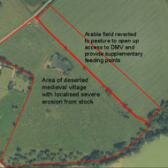Deserted Medieval Village at Hill Court Farm
Region: West Midlands
Local Authority: Wychavon
Owner Type: Private
Funding Body: DEFRA (Countryside Stewardship)
Year of Intervention: 2002
Summary: Hill Court Farm example: sustainable solutions for securing the future of archaeology in rural landscapes under Countryside Stewardship.
Description: Hill Court Farm contains the earthwork remains of a medieval village settlement dating back to Domesday, deserted through the late medieval and post-medieval period. The village developed next to a moated site, with its associated field system in the surrounding fields now showing as ridge and furrow. The site is one of the more ‘complete’ earthwork DMVs in Worcestershire, and its prominent boundary banks in a hilltop location leads to the possibility that it occupies an Iron Age enclosure. One large permanent pasture field contains the majority of earthworks, and is grazed by young cattle at a high stocking density, upon which the farm economy depends. The Farming and Wildlife Advisory Group were asked to consider the farm for entry into Defra’s Countryside Stewardship grant Scheme. They consulted the Worcestershire County Council’s Historic Environment Countryside Advisor, a post part-funded by English Heritage.
Issue: Medieval building platforms and a boundary bank were suffering from severe erosion around ‘pinch-points’ where tractor and stock were restricted to narrow access points across the earthworks. More general erosion was taking place by a gateway where the young cattle were supplementary fed and watered. Within the present field, no alternative access routes or supplementary feeding points could be identified. The farmer was willing to limit grazing to between March and November under Stewardship to protect the archaeology from poaching in the winter months, but erosion at the pinch points was still considered a major problem. A condition of the grant would be reduced stocking rates to enable wildflowers to develop, but this would result in scrub developing, and would also have been uneconomical. A viable alternative was needed to secure the future of the site.
Strategy: Following discussions with the farmer and FWAG farm advisor, an adjacent arable field provided the answer. It has been reverted to pasture, to be managed with no restrictions on supplementary feeding and watering, so young cattle can be retained for grazing the whole site at a high stocking density agreed with Defra. Once a fence was removed between the DMV field and the new field, a much greater area of the site was opened up for tractor and stock access, alleviating pressure on the surrounding earthworks
Outcome: The medieval settlement earthworks are under grass which is now grazed short without detriment to the farm economy, and grass cover has established over previously eroded areas. The earthworks are more visible from the adjacent Public Right of Way, and the farmer enjoys the benefits of grant-aid for managing the site in a sustainable way for the next 10 years and into the future. The project demonstrated that standard conservation prescriptions can rarely be applied without consequence to the farm economy, and that good communication between archaeologists, conservation advisor and farmers is key to finding solutions to problems that can threaten the future of archaeological sites in the rural landscape
Keywords: Funding, Preservation and Maintenance, Sustainability
© Worcestershire County Council/Jez Bretherton

